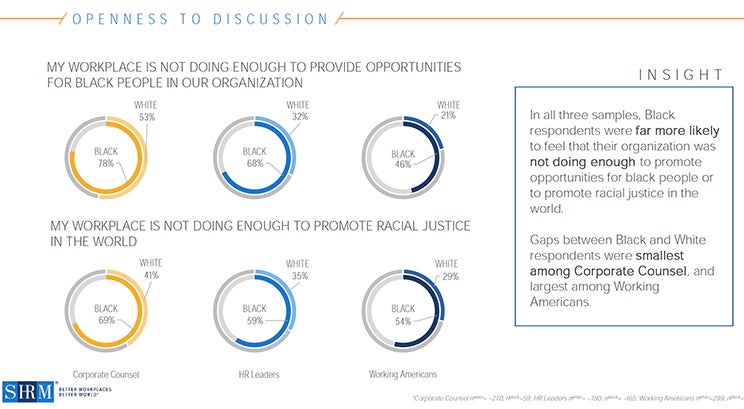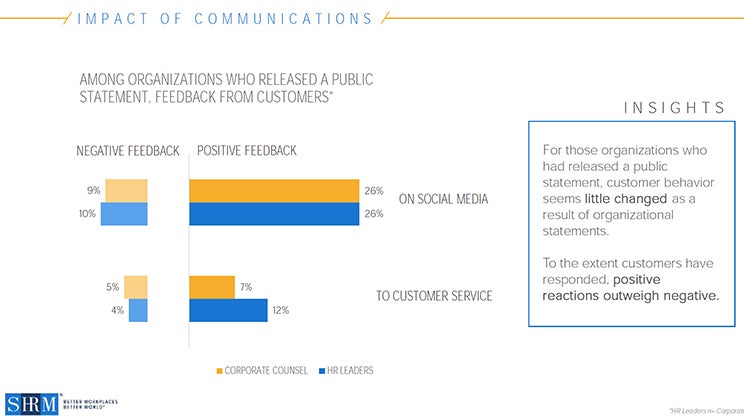
Sparked by the deaths of George Floyd and Breonna Taylor, protests for racial equality continue globally. Many companies have taken a stand, publicly denouncing police brutality and reassessing their policies to root out racial bias in their organizations. But how are the employees responding?
ACC and the Society for Human Resources Management (SHRM) joined forces to gather data to better understand the feelings of employees at this tumultuous time, how organizations can attempt to undo racial bias in the workplace, and how they can improve diversity and inclusion (D&I) programs. This data was presented in “Understanding the Journey to Equity and Inclusion: What the Data Tells Us,” the second part of a two-part webcast series. The first covered committing to workplace diversity and inclusion.
The latest webcast was introduced by SHRM President and CEO Johnny C. Taylor, Jr. and ACC President and CEO Veta T. Richardson, and hosted by Alexander Alonso, Ph.D., SHRM's chief knowledge officer. Alonso presented SHRM’s research data to illustrate how workplaces are responding to the call for racial equity and diversity.
The research focused on responses of ACC and SHRM members, in-house counsel, and HR employees, respectively. While Alonso said that there is data to be evaluated from other races and groups, SHRM and ACC’s joint study focused mostly on Black and white participants.
Lesson 1. Understanding the employee perspective
For organizations to root out racial bias in the workplace, they must first assess how their staff views race.
As mentioned in the first session, these conversations about race are tough, but they must be addressed for organizations to move the needle. Companies should provide forums (e.g., office town halls moderated by supervisors) that encourage employees to “be comfortable to be uncomfortable,” Alfonso says.
Survey respondents agree that they feel uncomfortable about race, but this discomfort manifests in different forms. For instance, Black employees were more likely to feel that their company wasn’t doing enough to support racial justice inside or outside the workplace, whereas white employees were more likely to believe that talking about race at work is inappropriate.

According to Alfonso, for Black employees to feel more trusting of their employers — and therefore more included at work — companies must allow open discourse for staff. Unfortunately, for years, dialogues about race were often stifled, as they’re considered taboo or polarizing.
Instead, topics about race should be a “discussion and not a debate,” Alonso clarifies. That way, everyone can share their perspective without becoming defensive. “It’s easier said than done,” Alonso adds, but it’s worth striving for.
Lesson 2. Understanding the organization’s role
Racial bias is still very much alive in workplaces, so how can organizations uproot racist practices from their offices? Companies might seem removed from the streets filled with throngs of protestors demanding social justice — in fact, 72 percent of corporate counsel reported that no protest occurred near their work facilities and didn’t have an impact on their business. However, company leaders can effect change from their office.
Communication initiatives
On the public-facing side, more than one in three organizations made statements specifically in support of protesters, according to SHRM’s research. The same study indicates that corporate counsel are more likely to support Black communities and protestors, whereas HR teams are more likely to support law enforcement.
The numbers show that companies taking a stance on this social issue benefits their brand. After making those statements, 26 percent of respondents have seen positive reactions on social media, and only nine to 10 percent have seen negative feedback. “All of this speaks to a high degree of relative neutrality and positive reactions outweighing the negative ones,” Alfonso observes.

Organizational initiatives
Within the organization, in-house counsel must directly address racial biases and accept that they are unfortunately and oftentimes unconsciously ingrained in decision-making. But there are ways to dismantle that mindset on an individual and operational level.
To help employees become more understanding, in-house counsel should partner with the HR team to hold regular trainings on racial bias, inclusion, and other diversity topics for employees. From a managerial side, the in-house counsel should also review company policies to remove any roadblocks that might prevent diverse candidates from being promoted.
Expansion on current D&I programs
Initially, companies focused more on the diversity side of D&I programs, namely in recruitment. In the past five years, these organizations have shifted their efforts to inclusion. The reason, Alonso notes, is that diversity policies only go so far:
“Diversity brings people into the workforce, but inclusion is what helps retain them and make them feel like they’re part of the corporate culture.”
Creating a more inclusive culture — one that encourages retention and promotion of diverse candidates — will help make the company more diverse and successful at every level.
Lesson 3. Playing the part in organizational impact
These D&I programs should be top of mind for months and years down the road — not just when there are protests in the news or holidays like Martin Luther King Jr. Day. Companies that “walk the walk,” Alonso says, should strive to achieve these six goals:
1. Recommit to culture and values
For a D&I program to work, the entire organization must commit to upholding these initiatives. Ensure that the tone starts from the top so that the rest of the staff will follow these progressive values and eliminate potential barriers to employment and promotion.
2. Practice inclusive hiring and promotion like you believe in it
Some companies have quotas for recruiting diverse candidates, but that only goes so far. Policies that focus on retaining and promoting diverse talent reinforce the importance of having a welcoming and progressive work environment. This includes “stackable” or less visible diverse attributes (e.g., sexuality orientation, disability, nationality) so that your D&I program is all-encompassing.
3. Have open dialogues about taboo topics
As mentioned earlier, discussing race relations at work can be uncomfortable, but we need to learn from each other’s perspectives to move forward in the workplace and in society. Employees must be reminded to be receptive to listen and not “dig themselves into a position,” as Alonso describes it, so that the polarization doesn’t increase.
4. Invest capital in social impact funds and CSR programs
Just as it’s important to ensure that your third-party vendors share the same values, so should the recipients of any indirect investments or social impact funds. For example, Nike donates indirect and direct investments to social impact funds to increase innovation in those communities.
5. Market to those who have been ignored
Consumer experiences must be improved, as diverse communities (e.g., Black, disabled, LGBT+) have not been well represented as customers until recently. “There’s a fiscal reason to leverage your brand to attract different demographics,” Alonso notes. Organizations must be conscious that their advertisements and marketing strategies reflect these consumers.
6. Rebuild your enterprise to be a force for good
Since “good” is subjective, it’s essential that your D&I programs match your company’s core values. There might be some backlash, but if the new initiative matches your brand, then your company will likely hear more praise than condemnation, as SHRM’s study shows, and have a more positive impact on the community.
Both webcasts are available on-demand through December 2020:
- Understanding the Journey to Equity and Inclusion: What the Data Tells Us (Part 2)
- A New Understanding of Workplace Diversity and Inclusion (Part 1)
For more webcasts on achieving racial equity in the workplace, as well as new D&I resources and content, visit the ACC I.D.E.A.L. Foundation page.




